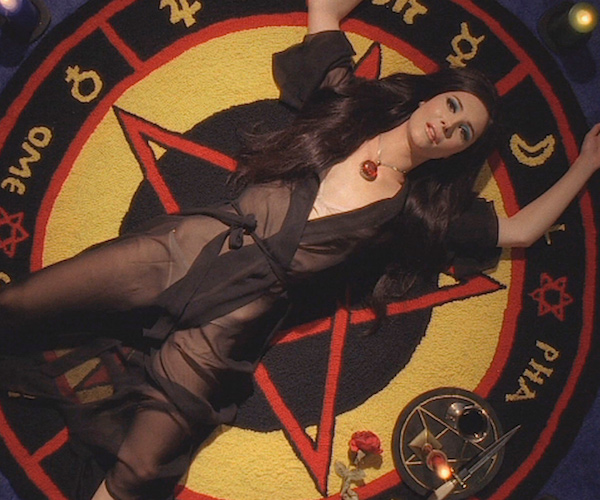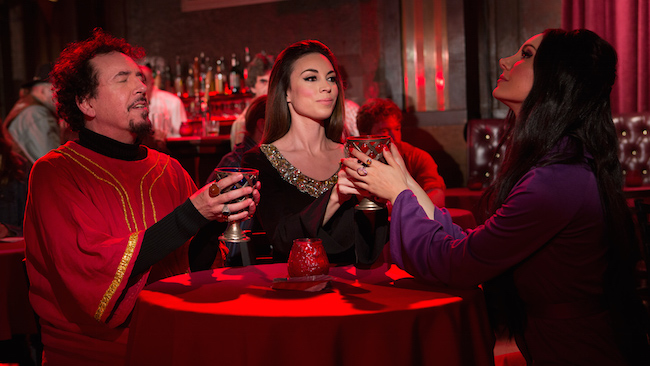Film Review: “The Love Witch” — Retro Horror in Delicious Color
Shot in gorgeous 35mm, The Love Witch is sure to be one of the year’s most talked about achievements in cinematography.
The Love Witch, written and directed by Anna Biller. At Kendall Square Cinema, Cambridge, MA

Samantha Robinson in “The Love Witch.”
By Peg Aloi
Written, directed and edited by Anna Biller, this candy-colored homage to trashy horror and sexploitation is my pick for most visionary film of the year. The film’s color palette is delirious, reminiscent of Technicolor’s bejeweled tones. But the technical and aesthetic achievement of The Love Witch is only part of its charm; it is also a clever satirical take on feminism and romance, as well as a commentary on the figure of the witch in contemporary horror.
The plot: A young, beautiful witch named Elaine moves to a new city in northern California in search of love … performs a love spell to attract a man … befriends her realtor only to seduce her husband .. hangs out with witches at the local bar … accidentally kills several men using witchcraft … and all havoc breaks loose! Sound like a cheesy 1970s horror flick? It is! Shot in gorgeous 35mm (who does that on a small budget these days?) with a painstaking attention to detail, this is sure to be one of the most talked about cinematography achievements of the year.
The film opens with a classic retro shot of Elaine driving a red sportscar through the California hills. She is stopped by a cop who later turns up to question her in a homicide investigation. The opening scene is right out of a vintage ‘70s crime procedural like Emergency or The Mod Squad. Repeatedly while viewing this film I had the sensation of sitting in my parents’ den in 1974 watching a made-for-TV movie: the sets, costumes, music, cinematography are letter-perfect in their authenticity. Elaine is equally fetching in black lingerie or lacy Gunne Sax gowns, with eye makeup so bright it seems painted on. Even the somewhat stiff, arbitrary acting styles are brilliantly designed and calibrated to emulate the nostalgic TV vibe. The only anachronisms I noticed: a few modern looking cars and storefronts (no doubt due to budgetary constraints) and one character’s use of a smartphone. This begs the question: were these anachronistic elements intentional? And if so, what kind of homage are we looking at here?
Certainly the central character could be a being straight out of ’70s TV. Elaine, played with sex kitten insouciance by Samantha Robinson, relishes her role as Everyman’s fantasy, even though she often seems to falter at determining what her own needs are. The filmmaker’s exploration of female fantasy and pleasure is also a fascinating take on neo-pagan spirituality (modern witchcraft and Wicca), with a surprising amount of insider-derived knowledge of rituals, jargon, and trappings. I suspect the film will cause a bit of controversy in the pagan community, mostly due to people taking this as literal narrative and not a form of satirical commentary. The film often seems to be ridiculing modern witchcraft for its pretentious jargon (“Bright blessings!” is the smarmy greeting they use), but the presence of somewhat menacing tarot imagery and ritual dialogue drawn straight from notorious witch Alex Sanders, not to mention Elaine’s pragmatic and realistic use of sex magic and spellcraft, help create an intriguing backdrop to the action. Elaine is a complex character, at times seeming to be shallow and two-dimensional and at others nuanced and surprising. Her use of magic to manipulate men and ensnare a lover may not sit well with ethical witches, but it makes for an entertaining exploration of horror’s most sexist tropes and why they seem to endure and fascinate.

A scene from “The Love Witch.”
There’s a great deal of subversive feminist messaging here, with clever references to iconic films like The Accused and The Stepford Wives, among others. Feminism is a central theme, yet it is dealt with in a very unexpected manner celebrating stereotypes while simultaneously bashing them. Elaine’s love spells include herbs, crystals and used tampons; they are a bold comment on woman-centric spirituality. But the realistic accoutrements of magic are tempered with plenty of fantasy. When Elaine decides she’s smitten with the cop (Gian Keys, who perfectly embodies the wooden, smirking manly man we saw on TV every night in the ’70s), the two go on a horseback riding date and happen upon a Renaissance faire in the middle of nowhere. Elaine’s coven of witches are also working at the ren faire, and what ensues is hilarious and over-the-top, but also surprisingly dark (we’re reminded at last that this is a horror film above all else).
The Love Witch‘s narrative falters a bit towards the end, first disjointed and then ultimately somewhat flat and even confusing. Still, the journey — full of color, music, sex and a flawless array of vintage objects and moments — make this well worth the experience. Repeated viewings deliver added layers of symbolism and meaning throughout. The film is only playing in selected cities and I’d certainly recommend seeing it on the big screen (lucky Californians got to see it screened in 35mm; perhaps one of our local arthouses will follow suit at some point).
Peg Aloi is a former film critic for The Boston Phoenix. She has taught film studies for a number of years at Emerson College and is currently teaching media studies at SUNY New Paltz. Her reviews have appeared in Art New England and Cinefantastique Online, and she writes a media blog for Patheos.com called The Witching Hour
Tagged: Anna Biller, Peg Aloi, Samantha Robinson, sex magic, The Love Witch
